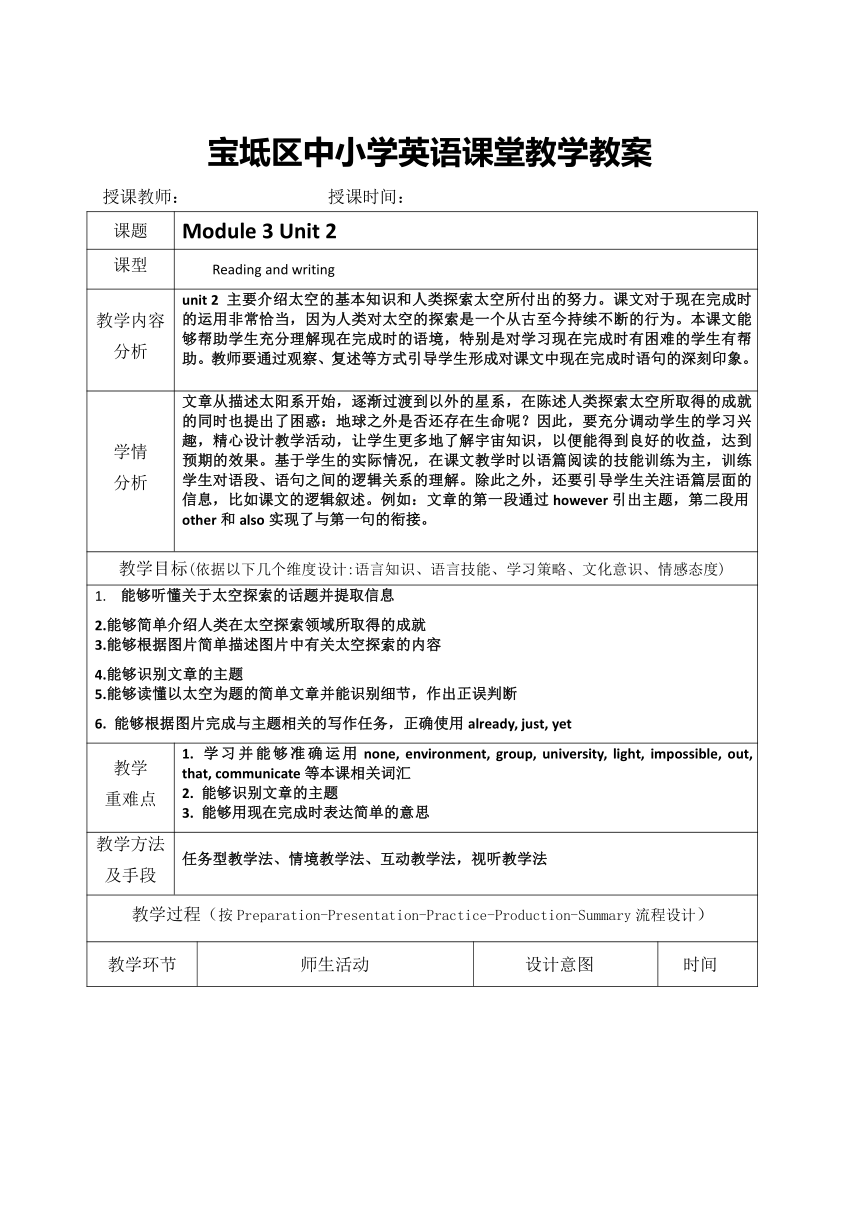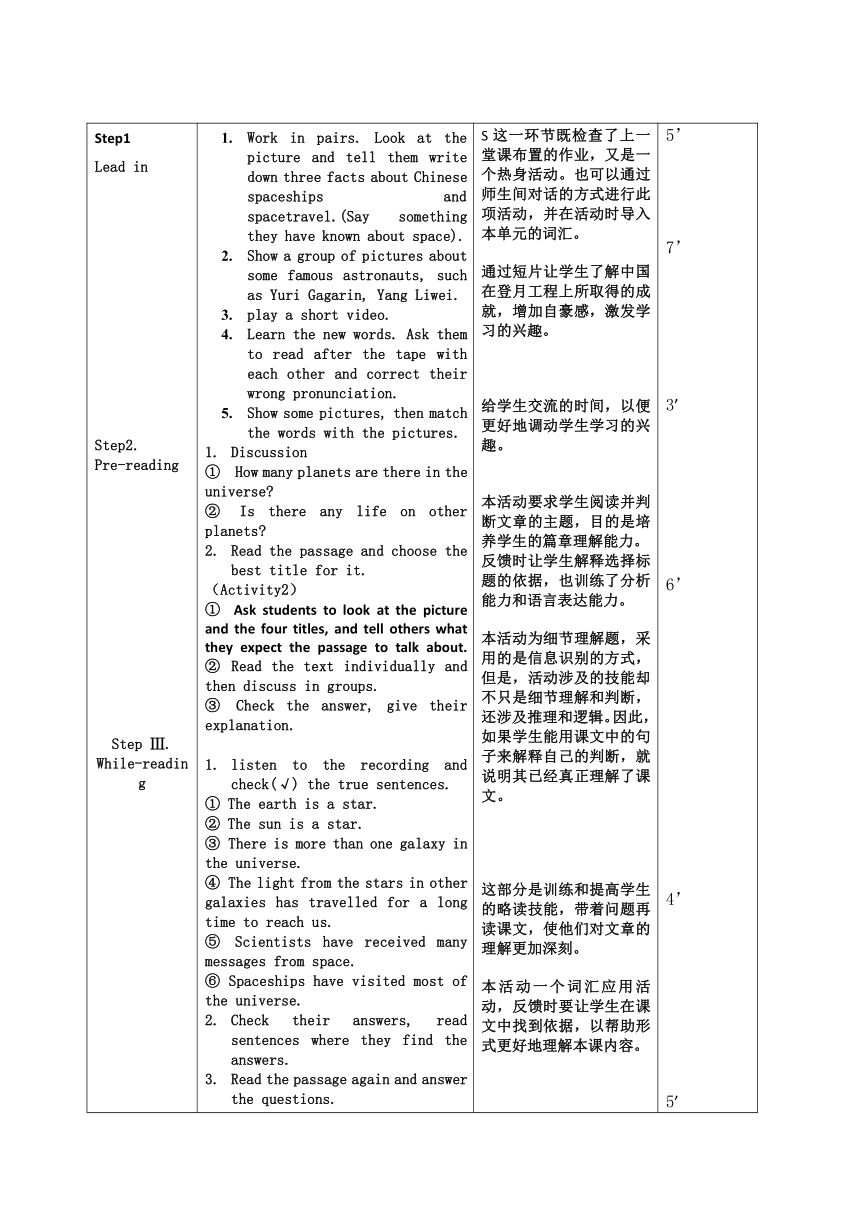Module 3 Journey to space Unit 2 We have not found life on any other planets yet.教案
文档属性
| 名称 | Module 3 Journey to space Unit 2 We have not found life on any other planets yet.教案 |  | |
| 格式 | zip | ||
| 文件大小 | 26.8KB | ||
| 资源类型 | 教案 | ||
| 版本资源 | 外研版 | ||
| 科目 | 英语 | ||
| 更新时间 | 2019-02-21 17:38:58 | ||
图片预览


文档简介
宝坻区中小学英语课堂教学教案
授课教师: 授课时间:
课题 Module 3 Unit 2
课型 Reading and writing
教学内容 分析 unit 2 主要介绍太空的基本知识和人类探索太空所付出的努力。课文对于现在完成时的运用非常恰当,因为人类对太空的探索是一个从古至今持续不断的行为。本课文能够帮助学生充分理解现在完成时的语境,特别是对学习现在完成时有困难的学生有帮助。教师要通过观察、复述等方式引导学生形成对课文中现在完成时语句的深刻印象。
学情 分析 文章从描述太阳系开始,逐渐过渡到以外的星系,在陈述人类探索太空所取得的成就的同时也提出了困惑:地球之外是否还存在生命呢?因此,要充分调动学生的学习兴趣,精心设计教学活动,让学生更多地了解宇宙知识,以便能得到良好的收益,达到预期的效果。基于学生的实际情况,在课文教学时以语篇阅读的技能训练为主,训练学生对语段、语句之间的逻辑关系的理解。除此之外,还要引导学生关注语篇层面的信息,比如课文的逻辑叙述。例如:文章的第一段通过however引出主题,第二段用other和also实现了与第一句的衔接。
教学目标(依据以下几个维度设计:语言知识、语言技能、学习策略、文化意识、情感态度)
能够听懂关于太空探索的话题并提取信息 2.能够简单介绍人类在太空探索领域所取得的成就 3.能够根据图片简单描述图片中有关太空探索的内容 4.能够识别文章的主题 5.能够读懂以太空为题的简单文章并能识别细节,作出正误判断 6. 能够根据图片完成与主题相关的写作任务,正确使用already, just, yet
教学 重难点 1. 学习并能够准确运用none, environment, group, university, light, impossible, out, that, communicate等本课相关词汇 2. 能够识别文章的主题 3. 能够用现在完成时表达简单的意思
教学方法及手段 任务型教学法、情境教学法、互动教学法,视听教学法
教学过程(按Preparation-Presentation-Practice-Production-Summary流程设计)
教学环节 师生活动 设计意图 时间
Step1 Lead in Step2. Pre-reading Step Ⅲ. While-reading Step4. Language points and practice. Step5. Writing. Step6. Practice. Step7. Homework. Work in pairs. Look at the picture and tell them write down three facts about Chinese spaceships and spacetravel.(Say something they have known about space). Show a group of pictures about some famous astronauts, such as Yuri Gagarin, Yang Liwei. play a short video. Learn the new words. Ask them to read after the tape with each other and correct their wrong pronunciation. Show some pictures, then match the words with the pictures. Discussion ① How many planets are there in the universe? ② Is there any life on other planets? Read the passage and choose the best title for it. (Activity2) ① Ask students to look at the picture and the four titles, and tell others what they expect the passage to talk about. ② Read the text individually and then discuss in groups. ③ Check the answer, give their explanation. listen to the recording and check(√) the true sentences. ① The earth is a star. ② The sun is a star. ③ There is more than one galaxy in the universe. ④ The light from the stars in other galaxies has travelled for a long time to reach us. ⑤ Scientists have received many messages from space. ⑥ Spaceships have visited most of the universe. Check their answers, read sentences where they find the answers. Read the passage again and answer the questions. ① Have we found any life on other planets? ② What is called solar system? ③ How many planets are there in solar system? ④ Have we discovered other galaxies in the universe? ⑤Is there life out there in space? Complete the passage with the words and expression in the box.(Activity4) Is there life on other planets? There are seven other planets in our__________, but_____ of them has a(n)___________ like that of the earth. Spaceships from the earth have done surveys of the other planets, but they have not found any life there. Why has no one from other planets tried to___________ with us? It is true that scientists have not discovered life on other planets in the_______ yet, but some scientists believe that they will find it some day. Students work in groups of four again, try to find difficulties and discuss together. If there are any problems, they may ask the teacher for help. At last share their work with the whole class. Then show language points. 2. Retell the one of these passage(use the phrases on the blackboard to help you). 1. Look at the picture from a science story for children and answer the questions. ① Where has the spaceship
landed? (Mars) ② What has the spaceship discovered? (people on Mars) ③ Why have the people on Mars not sent us a message? (do not know how to) Why have the people on Mars not visited us on the earth? (do not know how to) 2.Write a passage to describe the picture. Use your answers to the questions in Activity5 to help you. We have just received a message from our spaceship to Mars.. Search the Internet: ① Find out the English names of the planets in the solar system. ② What Chinese have done to explore the space.. 2. Revision the new words and phrases. S这一环节既检查了上一堂课布置的作业,又是一个热身活动。也可以通过师生间对话的方式进行此项活动,并在活动时导入本单元的词汇。 通过短片让学生了解中国在登月工程上所取得的成就,增加自豪感,激发学习的兴趣。 给学生交流的时间,以便更好地调动学生学习的兴趣。 本活动要求学生阅读并判断文章的主题,目的是培养学生的篇章理解能力。 反馈时让学生解释选择标题的依据,也训练了分析能力和语言表达能力。 本活动为细节理解题,采用的是信息识别的方式,但是,活动涉及的技能却不只是细节理解和判断,还涉及推理和逻辑。因此,如果学生能用课文中的句子来解释自己的判断,就说明其已经真正理解了课文。 这部分是训练和提高学生的略读技能,带着问题再读课文,使他们对文章的理解更加深刻。 本活动一个词汇应用活动,反馈时要让学生在课文中找到依据,以帮助形式更好地理解本课内容。 这部分这个环节是为了帮助学生提高学习的主动性,学会自主学习的方法,逐渐形成比较完善的阅读学习策略。 在理解文章的基础上进行语言的输出,既考查对文章的理解程度,又训练了现在完成时的运用。如有语法错误,可让其他同学予以纠正,也考查了学生听的能力。 这部分已经给出了提示,因此比较简单。先采用个体活动,然后两人一组互查的形式,要求用完整的句子回答问题。检查时,多关注学生所写句子的正确性,为下一个活动打下基础。 本活动是在上一活动基础之上进行,实际上就是连句组篇。要注意指导学生关注句子间的过渡和逻辑关系。 这部分练习是对学生掌握课文情况的一个检查,难度不大,可让基础稍差的同学来完成,多给予鼓励。 5’ 7’ 3’ 6’ 4’ 5’ 5’ 5’
作业布置 1.Search the Internet: ① Find out the English names of the planets in the solar system. ② What Chinese have done to explore the space.. 2.Revision the new words and phrases.
板书设计 Module 3 Journey Unit 2 We have not found life on any other planets yet. Key words We have just received a message from our spaceship to Mars … Present perfect
教学反思
授课教师: 授课时间:
课题 Module 3 Unit 2
课型 Reading and writing
教学内容 分析 unit 2 主要介绍太空的基本知识和人类探索太空所付出的努力。课文对于现在完成时的运用非常恰当,因为人类对太空的探索是一个从古至今持续不断的行为。本课文能够帮助学生充分理解现在完成时的语境,特别是对学习现在完成时有困难的学生有帮助。教师要通过观察、复述等方式引导学生形成对课文中现在完成时语句的深刻印象。
学情 分析 文章从描述太阳系开始,逐渐过渡到以外的星系,在陈述人类探索太空所取得的成就的同时也提出了困惑:地球之外是否还存在生命呢?因此,要充分调动学生的学习兴趣,精心设计教学活动,让学生更多地了解宇宙知识,以便能得到良好的收益,达到预期的效果。基于学生的实际情况,在课文教学时以语篇阅读的技能训练为主,训练学生对语段、语句之间的逻辑关系的理解。除此之外,还要引导学生关注语篇层面的信息,比如课文的逻辑叙述。例如:文章的第一段通过however引出主题,第二段用other和also实现了与第一句的衔接。
教学目标(依据以下几个维度设计:语言知识、语言技能、学习策略、文化意识、情感态度)
能够听懂关于太空探索的话题并提取信息 2.能够简单介绍人类在太空探索领域所取得的成就 3.能够根据图片简单描述图片中有关太空探索的内容 4.能够识别文章的主题 5.能够读懂以太空为题的简单文章并能识别细节,作出正误判断 6. 能够根据图片完成与主题相关的写作任务,正确使用already, just, yet
教学 重难点 1. 学习并能够准确运用none, environment, group, university, light, impossible, out, that, communicate等本课相关词汇 2. 能够识别文章的主题 3. 能够用现在完成时表达简单的意思
教学方法及手段 任务型教学法、情境教学法、互动教学法,视听教学法
教学过程(按Preparation-Presentation-Practice-Production-Summary流程设计)
教学环节 师生活动 设计意图 时间
Step1 Lead in Step2. Pre-reading Step Ⅲ. While-reading Step4. Language points and practice. Step5. Writing. Step6. Practice. Step7. Homework. Work in pairs. Look at the picture and tell them write down three facts about Chinese spaceships and spacetravel.(Say something they have known about space). Show a group of pictures about some famous astronauts, such as Yuri Gagarin, Yang Liwei. play a short video. Learn the new words. Ask them to read after the tape with each other and correct their wrong pronunciation. Show some pictures, then match the words with the pictures. Discussion ① How many planets are there in the universe? ② Is there any life on other planets? Read the passage and choose the best title for it. (Activity2) ① Ask students to look at the picture and the four titles, and tell others what they expect the passage to talk about. ② Read the text individually and then discuss in groups. ③ Check the answer, give their explanation. listen to the recording and check(√) the true sentences. ① The earth is a star. ② The sun is a star. ③ There is more than one galaxy in the universe. ④ The light from the stars in other galaxies has travelled for a long time to reach us. ⑤ Scientists have received many messages from space. ⑥ Spaceships have visited most of the universe. Check their answers, read sentences where they find the answers. Read the passage again and answer the questions. ① Have we found any life on other planets? ② What is called solar system? ③ How many planets are there in solar system? ④ Have we discovered other galaxies in the universe? ⑤Is there life out there in space? Complete the passage with the words and expression in the box.(Activity4) Is there life on other planets? There are seven other planets in our__________, but_____ of them has a(n)___________ like that of the earth. Spaceships from the earth have done surveys of the other planets, but they have not found any life there. Why has no one from other planets tried to___________ with us? It is true that scientists have not discovered life on other planets in the_______ yet, but some scientists believe that they will find it some day. Students work in groups of four again, try to find difficulties and discuss together. If there are any problems, they may ask the teacher for help. At last share their work with the whole class. Then show language points. 2. Retell the one of these passage(use the phrases on the blackboard to help you). 1. Look at the picture from a science story for children and answer the questions. ① Where has the spaceship
landed? (Mars) ② What has the spaceship discovered? (people on Mars) ③ Why have the people on Mars not sent us a message? (do not know how to) Why have the people on Mars not visited us on the earth? (do not know how to) 2.Write a passage to describe the picture. Use your answers to the questions in Activity5 to help you. We have just received a message from our spaceship to Mars.. Search the Internet: ① Find out the English names of the planets in the solar system. ② What Chinese have done to explore the space.. 2. Revision the new words and phrases. S这一环节既检查了上一堂课布置的作业,又是一个热身活动。也可以通过师生间对话的方式进行此项活动,并在活动时导入本单元的词汇。 通过短片让学生了解中国在登月工程上所取得的成就,增加自豪感,激发学习的兴趣。 给学生交流的时间,以便更好地调动学生学习的兴趣。 本活动要求学生阅读并判断文章的主题,目的是培养学生的篇章理解能力。 反馈时让学生解释选择标题的依据,也训练了分析能力和语言表达能力。 本活动为细节理解题,采用的是信息识别的方式,但是,活动涉及的技能却不只是细节理解和判断,还涉及推理和逻辑。因此,如果学生能用课文中的句子来解释自己的判断,就说明其已经真正理解了课文。 这部分是训练和提高学生的略读技能,带着问题再读课文,使他们对文章的理解更加深刻。 本活动一个词汇应用活动,反馈时要让学生在课文中找到依据,以帮助形式更好地理解本课内容。 这部分这个环节是为了帮助学生提高学习的主动性,学会自主学习的方法,逐渐形成比较完善的阅读学习策略。 在理解文章的基础上进行语言的输出,既考查对文章的理解程度,又训练了现在完成时的运用。如有语法错误,可让其他同学予以纠正,也考查了学生听的能力。 这部分已经给出了提示,因此比较简单。先采用个体活动,然后两人一组互查的形式,要求用完整的句子回答问题。检查时,多关注学生所写句子的正确性,为下一个活动打下基础。 本活动是在上一活动基础之上进行,实际上就是连句组篇。要注意指导学生关注句子间的过渡和逻辑关系。 这部分练习是对学生掌握课文情况的一个检查,难度不大,可让基础稍差的同学来完成,多给予鼓励。 5’ 7’ 3’ 6’ 4’ 5’ 5’ 5’
作业布置 1.Search the Internet: ① Find out the English names of the planets in the solar system. ② What Chinese have done to explore the space.. 2.Revision the new words and phrases.
板书设计 Module 3 Journey Unit 2 We have not found life on any other planets yet. Key words We have just received a message from our spaceship to Mars … Present perfect
教学反思
同课章节目录
- Module 1 Feelings and impressions
- Unit 1 It smells delicious.
- Unit 2 I feel nervous when I speak Chinese .
- Unit 3 Language in use
- Module 2 Experiences
- Unit 1 I've also entered lots of speaking competi
- Unit 2 They have seen the Pyramids.
- Unit 3 Language in use
- Module 3 Journey to space
- Unit 1 Has it arrived yet?
- Unit 2 We have not found life on any other planet
- Unit 3 Language in use
- Module 4 Seeing the docto
- Unit 1 I haven't done much exercise since I got m
- Unit 2 We have played football for a year now
- Unit 3 Language in use
- Module 5 Cartoons
- Unit 1 It's time to watch a cartoon.
- Unit 2 Tintin has been popular for over eighty yea
- Unit 3 Language in use
- Revision module A
- Module 6 Hobbies
- Unit 1 Do you collect anything ?
- Unit 2 Hobbies can make you grow as a person.
- Unit 3 Language in use
- Module 7 Summer in Los Angeles
- Unit 1 Please write to me and send me some photos
- Unit 2 Fill out a form and come to learn English
- Unit 3 Language in use
- Module 8 Time off
- Unit 1 I can hardly believe we are in the city ce
- Unit 2 We thought somebody was moving about
- Unit 3 Language in use
- Module 9 Friendship
- Unit 1 Could I ask if you've mentioned this to he
- Unit 2 I believe that the world is what you think
- Unit 3 Language in use
- Module 10 On the radio
- Unit 1 I hope that you can join us one day
- Unit 2 It seemed that they were speaking to me in
- Unit 3 Language in use
- Revision module B
